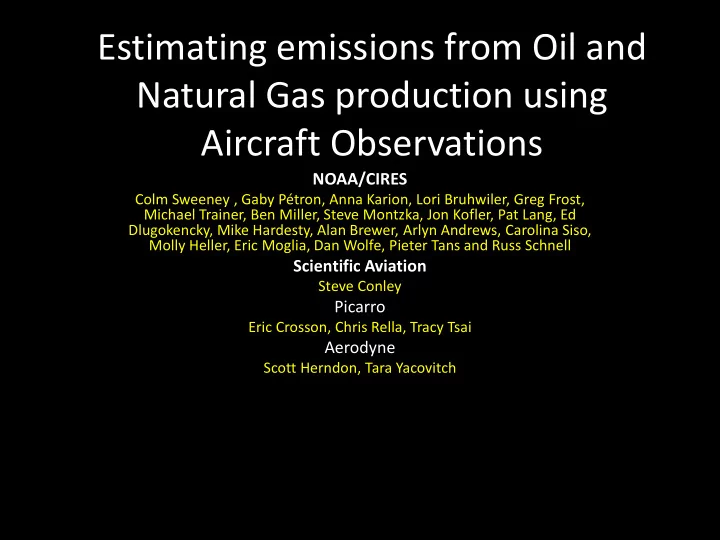

Estimating emissions from Oil and Natural Gas production using Aircraft Observations NOAA/CIRES Colm Sweeney , Gaby Pétron, Anna Karion, Lori Bruhwiler, Greg Frost, Michael Trainer, Ben Miller, Steve Montzka, Jon Kofler, Pat Lang, Ed Dlugokencky, Mike Hardesty, Alan Brewer, Arlyn Andrews, Carolina Siso, Molly Heller, Eric Moglia, Dan Wolfe, Pieter Tans and Russ Schnell Scientific Aviation Steve Conley Picarro Eric Crosson, Chris Rella, Tracy Tsai Aerodyne Scott Herndon, Tara Yacovitch
US Natural Gas Production US Energy Information Administration (EIA) 2005 Started shale gas boom
US Energy Strategy Foreign Reserves/ Climate Air Quality Cost Policy Storage Natural Gas Oil Coal Natural gas is portrayed in the US as a bridge fuel towards a more sustainable energy system
Is natural gas really a benefit to the climate? Percent natural gas leakage Gasoline Car Heavy-duty vehicle Coal Power plant Leak rate: 6.0 <1.8% <1.0% 4.0 <3.1% 2.0 0.0 Years until climate benefit is achieved 112 With only 3.1% leakage CH4 CO2 from well to power 72 GWP plant we will see 25 immediate benefit of 7.1 switching to electric 0 500 20 100 power. Time Alvarez et al. 2013
So what are the CH 4 emissions from natural gas in the US? 3 % CH4 Leak rate 2008 emissions EPA has changed their methodology 2 For 2008 Distribution EPA Inventory for estimating Transmission 1 production emissions Processing 0 twice in the last Production 2013 1 2 3 2010 2011 three years Report 15 2010 Report 2011 Report 2013 Report Tg CH4/yr 10 5 0 2004 2009 Production Transmission Distribution Year
Lower Production emissions? Top down measurement Petron et al. 2012: Used the measured atmospheric propane-to-methane enhancement ratios observed at the BAO tall tower and at the surface across the Front Range to evaluate the proportion of flashing and venting emissions. Bottom-up Emissions Top-Down BAO/ Mobile Lab Emissions Katzenstein et al. 2003: Used surface concentrations of CH 4 Texas, Oklahoma, and Kansas to suggest that EPA estimates were too low.
Aircraft Mass Balance Method mixing Wind Wind Downwind CH 4 height (PBL) Background CH 4 emissions Molar CH 4 enhancement in PB CH 4 flux + z b PBL ∫ ∫ = cos θ ∆ n V X n dz dx CH CH air 4 4 − b z gnd Perpendicular wind speed
Not just CH 4 in Aircraft Mass balance Attribution/History Aircraft: Mobile ground: HRDL: Aircraft: Tower: Continuous - PBL Continuous Continuous Continuous - CH 4 - Wind profiles - CH 4 - CH 4 - CH 4 - H2O - CO 2 - CO 2 - CO 2 - Temp - CO - CO - CO - Winds - H2O - H2O - H2O - Temp - Temp - Temp - Winds - Winds - Winds - Ethane - C-13 Flask Flask - Ethane - 55 species Flask - 55 species - 55 species
Past and Ongoing Studies in Western US Oil and Gas Fields Green River Basin, WY: high winter time surface ozone in natural gas field (Schnell et al., Nature, 2009) Barnett Shale, TX: Second largest shale gas field in the US. - March 2013 Uinta Basin, UT: Jan/Feb 2012 winter-time Denver Julesberg, CO: Hydrocarbon study of surface emissions from oil and gas ozone and its operations in 2008 in Weld County precursors (Pétron et al., 2012) - Feb. 2012 - May 2012 - Feb. 2013 9
Utah, 2012 CH 4 (ppb) downwind HRDL t l i upwind i K Distance perpendicular to wind (km) Karion et al. in prep
Uncertainty Variability (1 σ ) Parameter Mean Value Relative Uncertainty wind speed (V) 5.2 m/s 1.2 m/s 24% wind direction 55.2° 10.1° Vcos θ 3.8 m/s 0.7 m/s 24% ∆ X CH4 56.3 ppb 5.6 ppb 10% BL depth 1700 m 125 m 7% CH 4 Flux 56000 kg/hr 15000 kg/hr 28%
Inventory v. Top down Aircraft Mass Balance 10 Ground % Leak Rate C 3 H 8 /CH 4 8 State Inventory Aircraft 6 Mass Balance Top down 4 2 US EPA 2013 0
Can inventories work? 23 wells visited in Dish, TX all owned by the same company and built around the same time (by the same engineer) suggest that the inventory method which assumes that these well 0.0 all have the same emissions will 0.3 0.0 get it wrong. 0.3 0.8 11.7 0.0 0.1 0.2 0.0 0.3 2.9 0.8 0.0 0.2 0.1 0.3 0.0 0.1 0.0 23 wells (CH 4 enhancements ppm): No enhancements = 8 0.0 Small enhancements = 9 Large enhancements = 5 2.1 [Activity data] X [emissions factor ] = flux Data provided by Eric Crosson, Picarro
Conclusions – Mass balance estimates in UT and CO suggest that inventories underestimate leakage rates. – Ground measurement suggest that the inventories can not account for variability in emissions that exist in a typical oil and gas field.
Recommend
More recommend